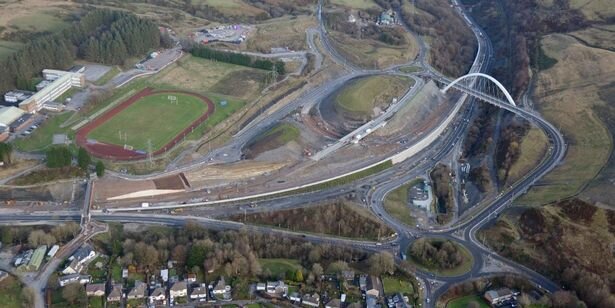Let’s Stop Building Roads. Wales Has!
Yesterday, Wales announced a freeze on all new road building.
It might be enough to make me support Wales in Euro 202o!
Stopping building new roads is so necessary and yet so hard to actually make happen.
Here in England, the Government is balancing the fanfare of £3 billion for the National Bus Strategy with a £27 billion roadbuilding programme.
Indeed, it’s amazing just how many new roads we are still building - in an environment where we know the consequences.
In Wales, the “Heads of the Valleys” project is too far advanced to be affected by the freeze: this is a major new dual carriageway connecting the top end of the Cardiff Valleys. Why is this connection a new dual carriageway and not a railway, when the gap is so obvious on the Cardiff Valley Metro map?
The Head of the Valleys dual carriageway being built, right now
But projects frozen include a new road link to Anglesey and a brand new dual carriageway on Deeside; both improvements to the A55 North Wales Expressway. The local rail service at Shotton has seen almost no investment in recent years.
The situation in England is, of course, even worse.
But why does this happen?
I think, in part, it is due to the way rail planners and road planners think.
Rail planners are from Mars and Road planners are from Venus
I got a coach recently. Not a Snap coach, sadly, circumstances are not currently propitious for that. But a coach.
My journey took me along that monster stretch of the M25 where it is 10 lanes wide.
There was a speed limit and a queue. Obviously…
Somehow, despite the road having virtually doubled in capacity in the 35 years since it was opened, it is still congested.
But it was always going to be.
Indeed, you could double it again, and it would still be congested.
We have proved time and time and time again that if you add transport capacity, people change their behaviour and travel more on that route. If you restrict transport capacity, people change their behaviour and travel less on that route.
By existing, the M25 has enabled countless people to reach out-of-town business parks, to drive round London to visit friends and family, to reach airports from destinations outside London, to go on holiday and to get to jobs. As a passionate believer in the social good of transport and connectivity, this delights me.
But, incredibly, the planners who widened it, didn’t do it because they wanted to enable more travel. They did so because they wanted the existing people to get there faster. This paper refers to a different section of the M25; the section from junction 23 to 27, which was widened to 8 lanes, but the principle is the same.
They weren’t widening it to enable more journeys, they were widening it to relieve congestion. i.e. to enable the same amount of traffic to move quicker.
The widened section from J23 - 27: still busy
It’s funny because transport planners in the different travel modes clearly don’t talk to each other.
When the West Coast Mainline was upgraded, the explicit aim was to shove more people along the tracks. The same with the Thameslink upgrade. The view was that if you increase capacity, you’ll fill it. And that’s a good thing. It’s called “induced demand” or, for informally, “build it and they will come”.
But engineers in road and rail think completely differently. Rail planners think in terms of capacity; highways engineers in terms of congestion.
The explicit goal of the M25 widening was to speed up journey times. And as the paper shows, it failed utterly:
Monitoring of traffic flows after the widening of the section of the M25 London orbital motorway between Junctions 23 and 27 found substantial increases in traffic volumes, of up to 23% two to three years after opening, but no increase in speed of travel beyond the first year. Comparison was made with the forecast traffic flows, made using a variable demand model based on SATURN software. The model projected increased traffic volumes and speeds as a consequence of road widening, but underestimated traffic volumes and overestimated traffic speeds compared to outturn.
The reality is that almost every road scheme fails on its own terms.
Highways engineers need to accept the proof provided by almost every major transport investment in any densely populated area (including those made by mistake such as the M41; see my previous post on this topic); that more capacity means more demand which means no improvement in journey times.
That means policy makers need to make a decision: yes, transport is a social good. More transport means more jobs, business meetings and happy family gatherings. But that social good can be achieved in ways that require vast environmental destruction, such as through road widening. Or much less environmental destruction, such as public transport.
We should obviously prioritise the modes that do last harm and offer the highest capacity. In neither case, is that roads.
So we must never, ever widen another road and never, ever believe a highway engineer who tells you that more road will mean faster cars. It won’t.
Wales has led the way and England must follow.
The reason it’s so hard is that Highways Engineers keep selling the dream that eliminating congestion will be achieved with just one more lane or just one more dual carriageway or just one more bridge to Anglesey.
It won’t.
Stop.
Now.



